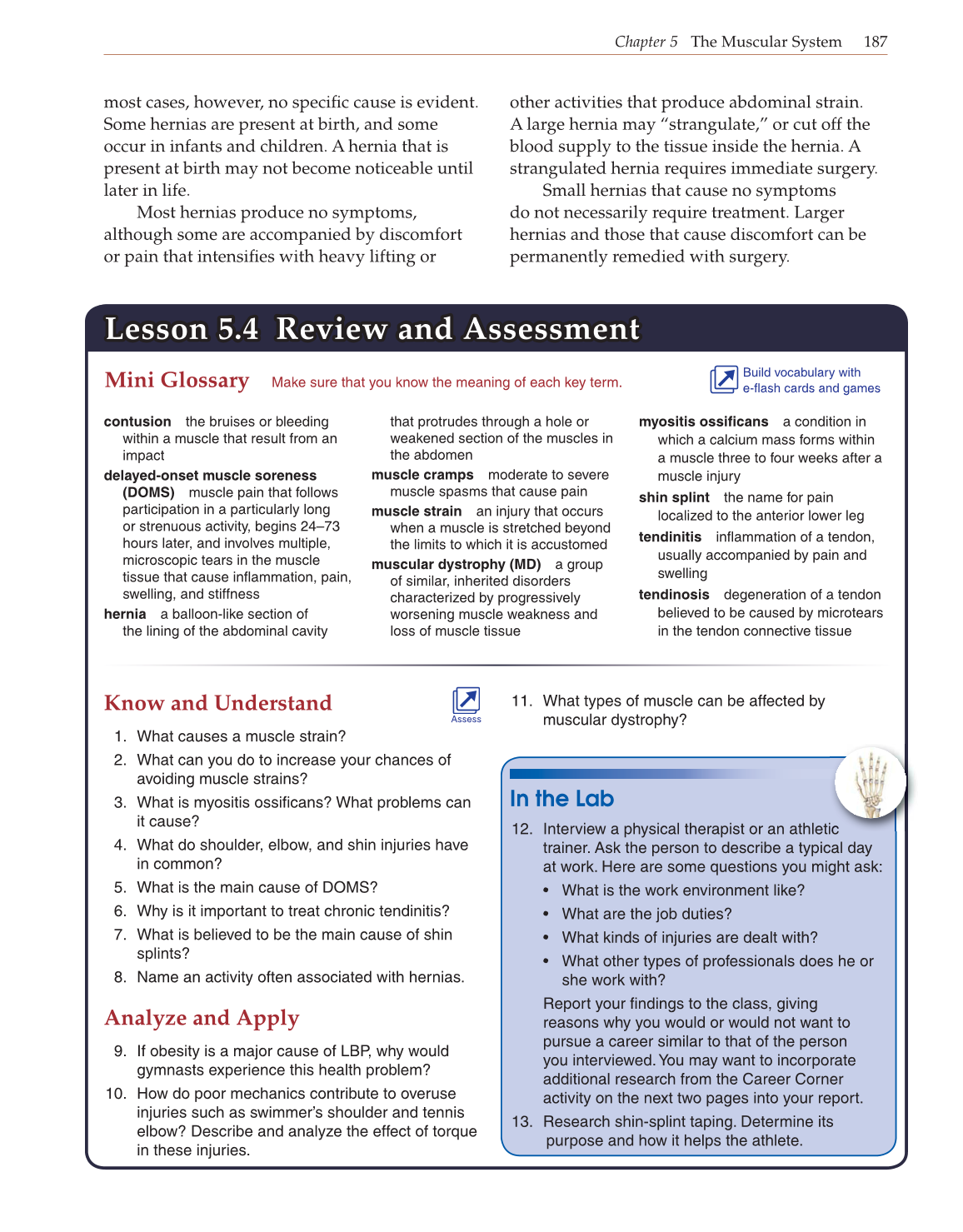Chapter 5 The Muscular System 187
Lesson 5.4 Review and Assessment Lesson 5.4 Review and Assessment
Mini Glossary
Make sure that you know the meaning of each key term.
contusion the bruises or bleeding
within a muscle that result from an
impact
delayed-onset muscle sore ness
(DOMS) muscle pain that follows
participation in a particularly long
or strenuous activity, begins 24–73
hours later, and involves multiple,
microscopic tears in the muscle
tissue that cause infl ammation, pain,
swelling, and stiff ness
hernia a balloon-like section of
the lining of the abdominal cavity
that protrudes through a hole or
weakened section of the muscles in
the abdomen
mu scle cramps moderate to severe
muscle spasms that cause pain
mu scle strain an injury that occurs
when a muscle is stretched beyond
the limits to which it is accustomed
muscular dys trophy (MD) a group
of similar, inherited disorders
characterized by progressively
worsening muscle weakness and
loss of muscle tissue
myositis ossifi cans a condition in
which a calcium mass forms within
a muscle three to four weeks after a
muscle injury
shin splint the name for pain
localized to the anterior lower leg
tendinitis infl ammation of a tendon,
usually accompanied by pain and
swelling
tendinosis degeneration of a tendon
believed to be caused by microtears
in the tendon connective tissue
Know and Understand
1. What causes a muscle strain?
2. What can you do to increase your chances of
avoiding muscle strains?
3. What is myositis ossifi cans? What problems can
it cause?
4. What do shoulder, elbow, and shin injuries have
in common?
5. What is the main cause of DOMS?
6. Why is it important to treat chronic tendinitis?
7. What is believed to be the main cause of shin
splints?
8. Name an activity often associated with hernias.
Analyze and Apply
9. If obesity is a major cause of LBP, why would
gymnasts experience this health problem?
10. How do poor mechanics contribute to overuse
injuries such as swimmer’s shoulder and tennis
elbow? Describe and analyze the effect of torque
in these injuries.
11. What types of muscle can be affected by
muscular dystrophy?
12. Interview a physical therapist or an athletic
trainer. Ask the person to describe a typical day
at work. Here are some questions you might ask:
• What is the work environment like?
• What are the job duties?
• What kinds of injuries are dealt with?
• What other types of professionals does he or
she work with?
Report your fi ndings to the class, giving
reasons why you would or would not want to
pursue a career similar to that of the person
you interviewed. You may want to incorporate
additional research from the Career Corner
activity on the next two pages into your report.
13. Research shin-splint taping. Determine its
purpose and how it helps the athlete.
In the Lab
ic
Assess
Build vocabulary with
e-fl ash cards and games
most cases, however, no specifi c cause is evident.
Some hernias are present at birth, and some
occur in infants and children. A hernia that is
present at birth may not become noticeable until
later in life.
Most hernias produce no symptoms,
although some are accompanied by discomfort
or pain that intensifi es with heavy lifting or
other activities that produce abdominal strain.
A large hernia may “strangulate,” or cut off the
blood supply to the tissue inside the hernia. A
strangulated hernia requires immediate surgery.
Small hernias that cause no symptoms
do not necessarily require treatment. Larger
hernias and those that cause discomfort can be
permanently remedied with surgery.
